This "crash course" on Cosmology closes with a brief consideration of the origin of our own Solar System and of several of the latest, provocative, and especially exciting theories (or brash speculations) on the Universe(s) that might be "out there".
The paradigm summarizing the processes involved in the formation of the Sun and its planets probably applies to other planetary systems in general. As of this writing (1999), planetary bodies have now been detected in at least a dozen (and perhaps more than 17 all told) other stellar (~solar) systems. Statistically speaking, the number of such systems should extend into the billions; it seems likely that non- or weakly-self-luminous bodies are the norm around a central star of normal nature (on the Main Sequence of the Hertzsprung- Russell diagram) as it proceeds through its developmental stages . Of course, these bodies are too small to be detected by direct observation using present day technology. A search for them is restricted to galaxies close enough to Earth for an individual star to be resolved to the extent that changes in its motion can be measured. Their presence is inferred as an explanation of a star's wobble, which may be expressed as slight systematic variations in light output, owing to gravitational interactions between that star and one or more orbiting planets.
A new and very exciting "discovery" by the Hubble Telescope was announced on May 25, 1998, namely the actual imaging (a first !) of what is being interpreted as a large planet around a star system. Again, the thermal infrared camera on HST was the key to acquiring this view because the planet' surface appears to be hotter than normal for solar system planets. What is shown below is a binary star pairing in a part of the sky known as the Taurus constellation. The star(s) are about 450 light years away.
The planet (which may be only a few tens of thousands of years old) appears as a bright dot (therefore probably quite hot - perhaps molten rock surrounded by incandescent gas -note the thin ringlike envelope) in the lower left of the image. The spherical body is several times larger than Jupiter in our system. It lies at the end of a glowing plume of gas and dust some 130 billion miles in length whose other end enters the thick envelope of hot materials around the two stars (superimposed in this view). One interpretation is that the body, dubbed TMR-1C, has been ejected from the central system; if so, this is a different mode of origin than considered the norm for the Solar System planetary formation (described below). Another possibility is that the plume represents materials being stripped away from the presumed planet (some have disagreed on this being "genuine") and carried by gravity towards the binary stars. Nevertheless, the early majority opinion is that this is a bonafide planetary body and there is broad consensus that others will be identified around closer-in stars over the next decade or so.
The first realistic notion of how planets form was proposed by Pierre Laplace in the 18th Century. In its modern version, both stars and their planets are considered to evolve from individual clots or densifications within larger nebular (cloudlike) concentrations dominantly of molecular hydrogen mixed with some silicate dust particles that spread throughout the protogalaxies and persisted even as these galaxies matured. In younger stars, much of the hydrogen and the heavier elements are derived from nova/supernova explosions that have dispersed them as interstellar matter that then may initiate clouds or mix with earlier clouds. Such nebulae are rather common throughout the Universe, as is continually being confirmed by new observations with the Hubble Space Telescope. Below are two views of nebular materials: Top = Orion galactic cluster; Bottom = part of M16 (Eagle) nebula, showing pillars of dust and gases from which stars and planets may eventually evolve (a few stars already being evident):
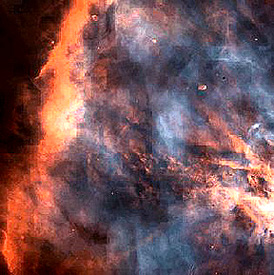
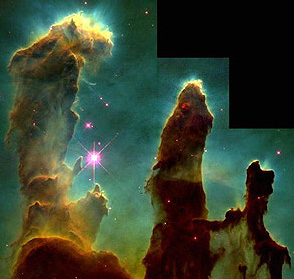
In this view, while most galaxies consist primarily of stars that formed early in galactic histories, stars continue to form well into younger times and even today from remaining nebular material. What is not yet known is the percentage of stars in a galaxy that actually have planetary systems. The low number so far found does not necessarily represent an indication of sparsity, since planets are so small and low in luminosity (mainly from reflected light) relative to their parent star that present direct observations will produce extremely low numbers, thus subjecting our current conclusions that planets may be rare to a misleading bias. Some models of star formation from gaseous nebula suggest that a fraction of the gases, dust, and free molecules is trapped in orbit without infalling to the central star and can organize in planets of various sizes, distances, and composition in a manner similar to our Solar System. If a valid argument, this says that planetary bodies are commonplace throughout the Universe.
A new telescope observation, reported in April, 1998, records the sighting (through the Keck II telescope on Mauna Kea, Hawaii) of what is interpreted to be another "solar" system around star HR 4796 (about 220 light years away). This image (at a resolution in which individual pixels stand out), taken in the IR, shows this central star (yellow white) surrounded by a lenticular (in an oblique view), flattened disk of gases and solid matter (glowing hot [reds] in the infrared):
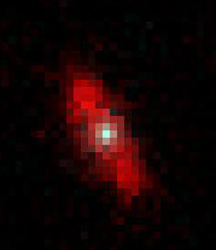
The diameter of the lens is about 200 A.U. No evidence of individual planets can be made out but the discoverers judge this feature, which has caused quite a stir of interest, to be an emerging planetary system in a "young adult" stage of development. It will certainly be a target for more detailed HST observations.
Theory indicates that, in the earlier stages of planetary formation, some number of broad rings should develop at various distances around the central star. One or more of these would appear as torus like glowing collections of dust and gases. At least two stars with this feature were imaged by HST and reported in January of 1999. Here is one of the star-ring systems:
Visible is a bright ring at some considerable distance out from the tiny parent star (white dot) and a more diffuse, darker mass extending beyond, both features occupying a flattened disc. In this instance, there are no rings close in (analogous to the regions occupied by the inner planets of the solar system). The white circle is added by the astronomers to mark a boundary; the broad black cross (X) is an optical artifact. This star is about 350 light years from Earth.
The following is a generally accepted model for establishing a planetary system: A nebula is subject to gravitational irregularities and other perturbations that cause free-fall collapse to numerous clots around which surrounding gases and particulates usually adopt a disklike form. In some instances, shock waves from a supernova can cause this matter to collapse and compress into protostars. Matter is also redistributed along magnetic field lines by magnetohydrodyamic processes. The main phases of planetary formation extend over about 10-20 x 106 years but it may require up to 108 years to progress from the early infall to the late T Tauri stage of a protostar's development. While a particular clot is organizing, the materials tend to redistribute such that hydrogen and much of the lighter elements flow towards a growing center to accumulate in a gravitationally balanced sphere, the star. Under one set of conditions, instabilities lead to a double (binary) star pair. As protostars form, the rotating gases and dust particles collect in a spinning disk around each center and eventually organize by accretion into planets. The same process, with variants, works at single stars.
Like other stars, the Sun (whose diameter is 1,392,000 km [870,000 miles]) is an end-product of gravitationally-driven condensation and collapse of hydrogen/helium gases and associated matter (both solid and gaseous) consisting of other elements and compounds that once made up a diffuse (density ~ 1000 atoms/cc) nebula. Probably many stars were generated in the timeframe of a few hundred million years from this particular "cloud". The protosun built up from centripetal, gravity-induced infall of nebular substances towards one of the concentration centers in the nebula. The bulk of the gases enters the resulting star itself along with much of the other materials, leaving an enveloping residue of matter enriched in Si, C, O (and H), N, Ca, Mg, Fe, Ti, Al, Na, K, and S (most organized into compounds, particularly silicates, that can be sampled by recovery of iron and stony meteorites - representing fragments of comets and broken protoplanets that are swept up onto Earth). This material, bound by gravity to the Sun but free to move inertially in encircling orbits, remained distributed in the space making up the Solar System. This system of particles rather rapidly organized into a disc-like shape whose present radius is about 100 A.U. (Astronomical Unit, defined as the average distance [149.6 x 106 km, or about 93 million miles] between the centers of the Earth and Sun; solar light takes about 8 and a half minutes to travel that distance; Pluto, lies 39.5 A.U. from the Sun whose gravitational influence is exerted well beyond). The disc rotated slowly (counterclockwise relative to a viewpoint above the north celestial pole [which passes through Polaris, the North Star]), its motion influenced by external gravitational effects from nearby stars.
As this rotation got underway, and thereafter, the stellar (solar) magnetic field churned up the dust and gases (descriptively compared to the action of an "eggbeater" in a thin batter) causing them to collect into clots much smaller than the Sun that underwent various degrees of condensation. This field also expels and guides this material into jets that carry matter out to great distances, as seen here in this Hubble Space Telescope view of a jet ejecting from another star in our galaxy:

Solar shock waves and intense radiation acted on the dust such that some of it melted into tiny droplets which chill into chondrules. These spherical bodies then were caught up with remaining dust to produce the primitive small solid bodies (fluffy "rockballs") that populated much of the heliosphere surrounding the Sun. We see samples of these bodies today as meteorites. Most infallen meteorites are ordinary chondrites that, in thin section, appear much like this sample from the Tieschitz meteorite:
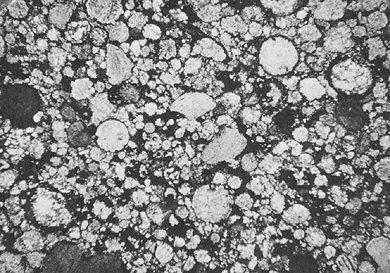
The most primitive meteorites, called carbonaceous chondrites, are enriched in carbon and contain water. Other meteorites are iron-rich (some with > 90% metallic iron), and may have once been the interiors of planetary bodies since disrupted. The chondrules themselves generally show a very limited size range, suggesting that ones larger than these fell back into the Sun through gravitational pull whereas smaller ones were swept away into interstellar space through expulsion by shock waves and solar wind.
Magnetically-driven eddies within the gas/dust cloud helped to impart additional angular momentum to the larger condensed rotating objects beyond the spherical Sun (which possesses only 0.55% of this momentum even though it contains 99.87% of the total mass of the system). These objects now remain in orbits around the Sun in positions that remain stable because of the counterbalance between centrifugal forces related to angular momentum and inward-directed gravitational pull from the Sun.
Planets appear to form simultaneously with the star around which they associate in well-defined orbits. As the formative process operated, local instabilities in the nebula tied to the Sun caused the chondrule-laden rockballs within turbulent zones to cluster
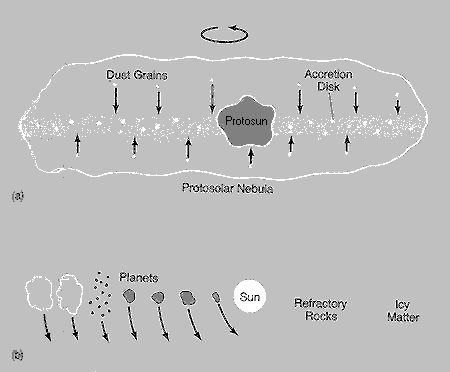
From J. Silk, The Big Bang, 2nd Ed., © 1989. Reproduced by permission of W.H. Freeman Co., New York
and further aggregate into objects ranging from meter-size up to planetesimal dimensions (tens to a few hundred kilometers, typified [perhaps coincidentally] by asteroid proportions). During this growth stage, smaller planetesimals tended to break apart repeatedly from mutual collisions while larger ones survived by attracting most of the smaller ones gravitationally, growing by accretion as new matter impacted on their surfaces. Once started, "runaway" growth ensues so that many planetesimals combine into bodies that eventually enlarge into fullblown planets. The bulk of the matter beyond the Sun was swept into the planets and their satellites, although some remains in comets and cosmic dust. Mercury, and some Outer Planet satellites are preserved remnants of this later stage in planetary growth, as indicated by their heavily cratered surfaces that were never destroyed by subsequent processes such as erosion. In contrast, the Moon appears to have built up by re-aggregation of debris hurled into space as ejecta from a giant impact on Earth soon after our planet formed; once collected into a sphere (which probably melted), the lunar surface continued to be bombarded with its own remnants as well as asteroids and other space debris. Its oldest craters are hundred of millions of years younger than the time at which the debris reassembled, melted and formed the lunar sphere; at least some of its larger basins are somewhat older.
In our Solar System, the four inner planets (the Terrestrial Group) are largely rocky (silicates, oxides, and some free iron; three with atmospheres) and the outer four (Giant Group) are mostly gases with possible rock cores. These Giants developed large enough cores to attract and capture significant fractions of the nebular gases dispersed in the accretion disk. The ninth planet, Pluto, the smallest and, at times, farthest out (its elliptical orbit periodically brings it within that of Neptune), appears to be made up of rock and ice and may be a captured satellite of Neptune.
Theoreticians differ as to the exact methods and sequence in which the planets accumulated after the condensation and planetesimal phases. Timing is a critical aspect of the formation history. One version - the equilibrium condensation model - considers condensation to happen early and quickly, in a few million years, with the observed sunward zoning of higher temperature minerals and greater densities in the rocky inner planets both being consequences of the increasing temperature profile inward across the solar nebula. Accretion was stretched out over 100 million years or so. The heterogeneous accretion model holds condensation and buildup of planetesimals to proceed simultaneously over a few tens of millions of years. Neither model adequately explains the fact that both high and low temperature minerals aggregate together in the inner planets to provide materials capable of generating the atmospheric gases released from these planets. The models also do not fully account for the strong preferential concentration of iron and other siderophile ("iron-loving") elements in the inner, terrestrial planets. One solution is to add (by impact) low temperature material to the growing protoplanets carried in along eccentric orbits from asteroidal and giant planet regions. This material is then homogenized during the total melting assumed for each inner planet early in its evolution (this melting is the consequence of heat deposited from accretionary impacts, from gravitational contraction, and from release during radioactive decay). As cooling ensues, materials are redistributed during the general differentiation that carries heavy metals and compounds towards the center and allows light materials to "float" upwards towards the surface.
Now, as a grand finale, let us turn to the challenging, mind-bogling thesis that ours may not be the only Universe (the information here presented was extracted from the Cover Story in the July 20, 1998 issue of the magazine U.S. News and World Report). In this review, the key word is "multiverse" which connotes the astounding notion that, theoretically, quantum cosmology allows for the possibility that many Universes may actually exist. We have already alluded to the fact that we are limited by the speed of light to detecting only those boundaries of our own Universe out to distances in the expanding space which contain galaxies, etc. that have transmitted radiation to us within the time frame of the Big Bang, i.e., are no older than the apparent age of the Universe (best estimate, 15 b.y.). Paradoxically, there may be parts of this Universe that are presently beyond this time horizon and won't be detected until later (for example, in a billion years astronomers will then see that part of the Universe that involves this additional time interval).
The conditions - the Laws of Physics and the particular values of fundamental parameters such as the speed of light, the gravitational constant, the magnitudes of the other basic forces (e.g., the nuclear strong force), the ultimate amount of mass, the rate and duration of inflation, and other key constants - that operate in our Universe are "fine-tuned". None can vary by too much from their narrow, critical specific values or the Universe would have expanded too fast or too slow, or might not ever have organized into the present assemblage of matter. The fact that it did is remarkable, but had things been much different, the conditions favoring life would not have occurred - probably on the grand scale that is represented not only on Earth but in countless planets in innumerable galaxies. This situation - at the heart of the Anthropic principle - suggests that special factors must be present for a Universe to succeed.
If the Universe began as now believed - from a sudden, extremely favorable and positive fluctuation of a quantum state in the so-called "false vacuum" in which a virtual particle instantaneously sprang into existence, containing within it all the potential energy needed to produce the matter and radiation now making up the Universe - then there is a real theoretical likelihood that the process could be repeated again and again, many times (perhaps infinitely). Thus, Universes could be springing forth from the endless (infinite in both space and time) vacuum that nevertheless contains the "quantum capability" of fluctuations bringing individual Universes (the multiverses) into existence. Each one establishes its own space which enlarges after its own time-clock is started. None of the Universes is (can be) in contact with any of the others. They all exist independently. We have no known way of communicating with other Universes (for that matter, we are very limited in communications within our own Universe) and, unless some future "breakthrough" in theory and practice that facilitates this communication happens, we will never advance beyond developing plausible models that hint that multi-universes are the norm.
A variant of these ideas has Universes coming into being from Black Holes. The question then becomes one of origin of the Holes themselves. To be a Black Hole, a nearly infinite amount of matter must be somehow concentrated in a space that can range from a few tens of kilometers for Holes that are residual to star destruction processes (beyond the neutron star stage) to essentially point (dimensionless) sizes resulting from other causes. Our own Universe contains countless Black Holes of varying sizes. Under the right circumstances, a Hole may explode, initiating a new Big Bang.
Another concept is the offspring of the Inflation process. As this early phase proceeds, a segment containing a false vacuum would develop a bubble-like bulge that is connected by a neck-like extension known as a "wormhole". This can break from the parent expansion to drift free as a "daughter" Universe that undergoes its own development, which includes its own inflation and expansion. There might even be a single Mother Universe (probably not ours) from which countless Universes are spawned. This "Super Universe" has always been and serves as the master control for the perpetual series of quantum fluctuations that lead to multiverses. Each remains "out of touch" with other Universes, never interconnecting or physically contacting in the Super Universe within which space only has meaning (to the finite, limited human mind) to the inhabitants of each daughter Universe. Time in any such offshoot Universe will, in principle, be measured from its explosive conception, but time throughout the super system may be infinite.
Of course, not ever Universe is successful beyond its early moments. Inflation may fail, the fundamental constants may be "off" so that expansion is abnormal, or other conditions prevent a Universe from experiencing a proper development. Some Universes may be short-lived; others expand so slowly that factors promoting galaxy and star development inhibit attainment of a situation favoring life. But many astronomers and cosmologists now believe that there is a natural inclination - in a sense, a purpose - for Universes to "try" to develop in a manner that points to occurrence of Life as a "goal". A good espousal of this seeming teleological control of Universe formation is the book by Lee Smolin, The Life of the Universe, Oxford Press, 1997. Dr. Smolin presents the thesis that Universes are evolutionary - "natural selection on a cosmic scale" (U.S. News). For an adventure of the mind, read this book.
In closing, contemplation of Cosmology, and its astronomical substructure, is a truly humbling experience for one's brain. The wonder is: that there exists on one tiny point in a humongous Universe something called the "conscious" and that the human mind (yours, for instance) can conceive of, and begin to understand, the truths of this Universe's attributes and history that are continually being discovered and refined. Finally, it is both astonishing and reassuring to realize that all beings - be they people or animals/plants or inanimate matter - are remarkably cosmological in nature: All the atoms in our bodies were once contained in stars or interstellar space; our parts in a sense are variously billions of years old and their atomic constituents, even after multiple dispersions and reassemblies, will last at least as long as the present Universe - estimated to continue for perhaps 50 b.y or more. In one way, then, our essences will have achieved some kind of plausible Immortality in view of the many incarnations that preceded our current atomic arrangement and are yet to happen. But, from the humble side, perhaps "We are not alone" and certainly we are not at the center of the known Universe; our importance is sui generis and our rank among the Universe's populations is probably just average.
NOTE: No extended attempt has been made in the above review to offer any metaphysical explanations for the origin of the Big Bang itself or to postulate what might "be" before this event. There are both plausible religious and philosophical rationalizations and purely scientific arguments. For the curious, these paperback books by Paul Davies offer valuable insights: God and the New Physics; The Cosmic Blueprint; and The Mind of God [especially Ch. 2]., Touchstone Books, Simon & Schuster, Inc. A book that relates cosmological discoveries to teachings associated with the Christian God is Beyond the Cosmos by Hugh Ross, Oxford Press, 1996. A more general overview of arguments contrary to the exclusively natural and spontaneous Universe such as described in this subsection is given in the 1997 book by Dean Overman and Wolfhart Pannenber, A Case against Accident and Self-Organization, Rowman & Littlefield.
An informative Web Site that reviews some fundamentals of Cosmology: http://map.gsfc.nasa.gov/html/web_site.html
Code 935, Goddard Space Flight Center, NASA
Written by: Nicholas M. Short, Sr. email: nmshort@epix.net
and
Jon Robinson email: Jon.W.Robinson.1@gsfc.nasa.gov
Webmaster: Bill Dickinson Jr. email: rstwebmaster@gsti.com
Web Production: Christiane Robinson, Terri Ho and Nannette Fekete
Updated: 1999.03.15.